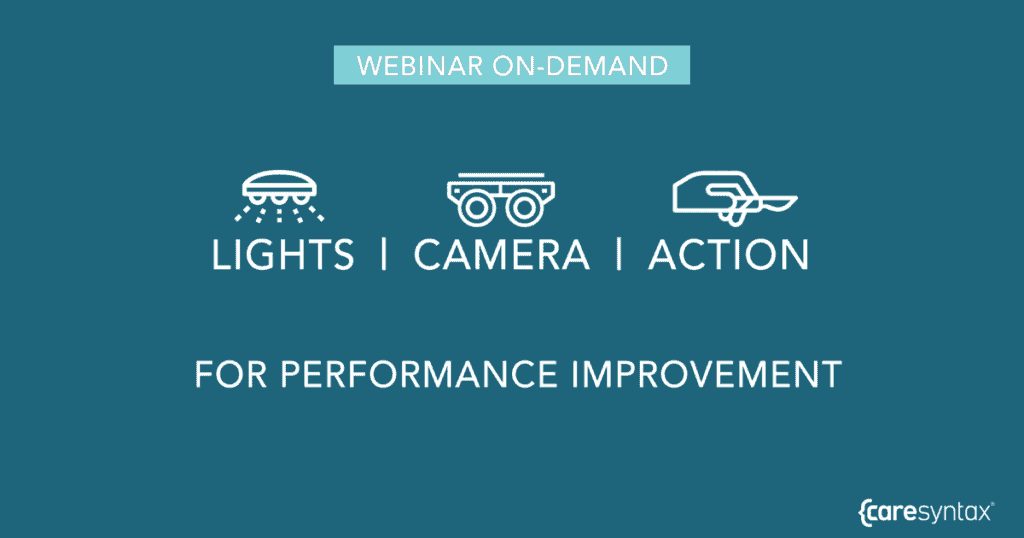
Webinar
Lights, Camera, Action – for Performance Improvement
Read More

Caresyntax Article
February 15, 2023
My career began at the advent of minimally invasive surgery, at a time when the surgeon, not the patient, dictated the approach to care. But now we are seeing a transformational shift based on a growing understanding of systems and data science that is demonstrating how critical data is to surgical improvement, patient outcomes, and financial sustainability.
We are now working toward greater understanding about how to apply the principles of data science to real patient care. Surgeons and healthcare providers need to emulate the revolutionary approaches demonstrated by Netflix and Major League Baseball that showed how leveraging data and analytics offers greater insights—insights you would never get by relying solely on individual experience.
What those organizations did is what we should be doing in healthcare: We need to take that data and leverage it to personalize care recommendations, by gaining a better understanding of subpopulations, local variation, and biologic variation. We need to turn that kind of market segmentation into patient segmentation in healthcare.
Historically we have used the one-size-fits-all reductionist approach of prospective, randomized, controlled trials, which assume causation when identifying the statistical significance of isolated factors. The true definition of standardization is not uniformity, but optimum variety. We need to learn how to apply the principles of variability to healthcare. Instead of relying on averages, we should be learning how to use data and analytics to understand the optimal value of different treatment options for different patient sub-populations.
In the book The End of Average by Todd Rose, he talked about the early days of the US Air Force and its desire to find out why planes were crashing every day–not in combat–but during regular exercises. On the worst day, 17 planes crashed. Finally, a young engineer discovered the problem. When the planes were being designed, they relied on over a hundred and twenty biometric measurements (head circumference, arm length, average leg length) to design a cockpit for the average pilot size. But the problem was, there was no average size pilot. They discovered that what they really needed were adjustable sized cockpits and pilots of a limited size to safely manage the cockpit controls.
We need to learn how to apply the principles of variability to healthcare, learning how to use data and analytics to understand, not the average, but the optimal.
Working with a biologic engineer, when we studied explanted hernia meshes, we found a level of complex biologic variability that blew my mind: The same mesh used the same way in two different people can have very different outcomes and very different biologic interactions. It led to the understanding that there are many factors that correlate to benefits, waste, or unintended harm. It showed that we need a data and analytics infrastructure in healthcare to develop the algorithms and insights to understand those different factors.
The tools from systems and data science can generate weighted correlations for the most important factors and combinations of factors that will give insights to improve outcomes for preventative care and treatment for specific patient populations. Systems science can accommodate constant change and biologic variability by using the principles of feedback loops.
The feedback loops offered by systems science can be leveraged to inform both clinical teams and patients, which can also measure improvement in outcomes over time. It opens up the ability to measure the entire surgical workflow from preoperative risk prediction and patient optimization for elective procedures to post-operative enhanced recovery, improving value-based outcomes, and ultimately leading to disease prevention.
A recent article about the gap between public datasets to real-world data for surgical phase recognition[i] highlighted the challenge of current approaches to healthcare data. A large, private dataset recorded in a continuous time frame of five years of 384 laparoscopic cholecystectomy (Lap Chole) videos, including emergency surgeries and teaching cases, found that the public datasets for surgical phase recognition differ from the data that is observed in real-world conditions. This data distribution discrepancy can bias the development of deep learning model and, eventually, affect the final data product. Similarly, the data and conclusions generated by controlled clinical trials have not translated well into real-world patient care. That is why the 21st Century Cures Law has mandated that the Food and Drug Administration move away from controlled clinical trials and instead use real-world patient data with complex adaptive methods for the regulatory process in the United States.
The structure of electronic health records (EHR) makes it difficult to integrate unstructured data,[ii] including video and conversations among the clinical team. As a result, much of that valuable information is lost or left unused.
Poor EHR system design and improper use can cause EHR-related errors that jeopardize the integrity of the information in the EHR that can endanger patient safety or decrease the quality of care. Usability errors occur as a result of system complexity, lack of user-friendly functionality (e.g., confusing user interfaces), workflow incompatibility, or limitations of the user. [iii]
If you combine machine learning and advanced analytics with static, EHR-stored information, it can uncover surgical variations, risks to patient safety, and inefficiencies in workflow and communication.
If you combine machine learning and advanced analytics with static, EHR-stored information, it can uncover surgical variations, risks to patient safety, and inefficiencies in workflow and communication. Leveraging technology lets you establish initial variability baselines for operational, clinical, and financial KPIs, not just the tyranny of averages. We need to have infrastructure to pull the data and quickly see the analytics to be able to interact with the data to get meaningful insights.
When you capture and aggregate real-time information from myriad sources and integrate it with static and retrospective data stored in the EHR, it can lead to more holistic details of a patient’s condition that can be shared with the entire clinical team.
As I learned about, and then applied, the principles of data science to real patient care, I’ve realized how much better our decision-making process in healthcare could be if we had a data and analytics infrastructure that could generate, not just predictive algorithms, but predictive algorithms that improve value-based outcomes over time for all patients.
Data-driven surgery helps us focus on optimal analytics and data to identify the best value treatments for patients. Getting all the data you need, in advance, can help improve case planning and ensure the right surgical or non-surgical approach.
Pulling in healthcare data from various sources–preoperative imaging, real-time guidance and postoperative analytics, personalized surgical playbooks, variability analytics and high-fidelity surgical records—has the potential to improve value-based outcomes and efficiency. The move to a sustainable value-based model for healthcare is a global issue. In fact, in 2019, The World Economic Forum began a global coalition for value in healthcare. This is a global public-private partnership to accelerate the transition to value-based healthcare in health systems throughout the world.
When we learn and apply the principles of systems science and build a data and analytics infrastructure for learning and improving, we will have the transformation tools required to build a sustainable healthcare system.
When we learn and apply the principles of systems science and build a data and analytics infrastructure for learning and improving, we will have the transformation tools required to build a sustainable healthcare system.
As we become more skilled in using data science principles, we are going to see the potential for our healthcare system to be transformed. Moving from a global healthcare system based primarily on volume to a sustainable system based on value for patients can unify all stakeholders that contribute to a sustainable healthcare system that is available and beneficial to all people globally.
Bruce Ramshaw, MD, FCAS, is co-founder and CEO of CQInsights, a healthcare data analytics company; a member of the International Advisory Council at APCO, and a global Medical Advisor for Caresyntax. He served as chair of Surgery at The University of Tennessee Graduate School of Medicine in Knoxville, Tennessee, chair of the Halifax Health Medical Center General Surgery Residency Program in Daytona Beach, Florida, was chief of General Surgery and associate professor, and he held the John A. Growden Professorship in Surgery at the University of Missouri, Columbia. He held appointments at Emory University School of Medicine as assistant professor of Surgery and as the director of the Hernia Institute. He is currently serving on the Society of American Gastrointestinal Endoscopic Surgeons (SAGES) Communications Committee on Quality Outcomes and Safety Committee. He was a charter member of the Atlanta Surgical Association. Dr. Ramshaw has also been a board member of the ABC’s Telemedicine and Telehealth advisory board. He is a medical advisor for Caresyntax and the opinions expressed in this article are his own.
References
[i] Kirtac K, Aydin N, Lavanchy JL, Beldi G, Smit M, Woods MS, Aspart F. Surgical Phase Recognition: From Public Datasets to Real-World Data. Applied Sciences. 2022; 12(17):8746. https://doi.org/10.3390/app12178746
[ii] Paul Summerside, MD. Why Your EHR is Holding You Back. Caresyntax Smart Surgery blog. 1 Aug 2018.
[iii] Bowman S. Impact of electronic health record systems on information integrity: quality and safety implications. Perspect Health Inf Manag. 2013 Oct 1;10(Fall):1c. PMID: 24159271; PMCID: PMC3797550.